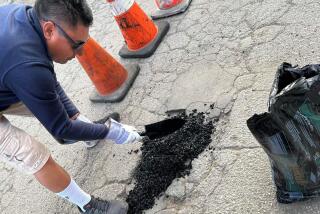L.A.’s potholed streets must be made safe for cyclists -- or else
One of the top complaints of Angelenos in recent years has been the, shall we say, sub-optimal condition of the city’s roads. If city officials can persuade more residents to get out of their cars and onto their bicycles, the wear and tear on the roads will diminish. But there’s a flip side: The city may face more lawsuits from cyclists who are toppled by potholes, pavement cracks and other hazards of the city’s worn streets.
And that raises an interesting question: Will Los Angeles have to maintain its roads at an even higher standard than the one it’s not meeting today?
As most cyclists will tell you, it’s almost never their fault when they get tossed from their bike. According to the city attorney’s office, however, state law has specific guidelines for determining whether local governments can be held liable in the event of a spill.
FULL COVERAGE: Sharing the road in L.A.
First, the bicyclist’s injury had to result directly from a “dangerous condition” on the government’s property. Second, said condition created a “reasonably foreseeable risk” of the kind of injury the cyclist suffered. And third, either the condition was created by a government employee acting within the scope of his or her employment, or the government knew or should have known about the condition far enough in advance to have fixed it (or at least put orange cones around it).
Jim Pocrass, an attorney at Pocrass & De Los Reyes who has brought a number of these claims on behalf of injured cyclists, noted that a pothole or crack in the road that posed no menace to cars may, in fact, be dangerous to a cyclist. And “if they have the right to be on the roadway, that roadway has to be safe,” he said.
The most straightforward case involves hazards created by city workers or contractors. Under the law, they’re liable for injuries unless they can show that the act or failure to act that created the hazard was reasonable -- for example, when a construction crew lays a steel plate over a hole in the pavement, temporarily creating an uneven surface.
More commonly, though, hazards arise as streets gradually deteriorate. In those cases, injured cyclists have to show that the city had been told or should have known about the danger, which means proving that the hazard would have been discovered by an inspection system that was “reasonably adequate” and operated with “due care.”
Pocrass said cash-strapped budgets aren’t a valid excuse for failing to detect a hazard that has been in a roadway for months, especially if the injured cyclist can show that city employees pass through the area regularly (e.g., meter readers). The implication is that all such workers should be on the lookout for potentially dangerous street conditions, so they can report them and have them fixed.
Still, the crucial question here is one of reasonableness. Mayor Eric Garcetti’s new performance index rated the average street surface at 61.2 on a scale of 0 (worst) to 100 (best) in 2011, the most recent year measured. That means virtually any route a cyclist might take in Los Angeles is going to pass over some pockmarked streets. Is the city taking steps that are “reasonably adequate” to identify dangerous conditions and mitigate them? What does that mean in a city with 16,785 miles of public roads?
Pocrass said the city has called on landowners to report potentially dangerous conditions on the roads and sidewalks in front of their property. If that leads to more potholes and cracks being fixed, that’s a good thing. If it doesn’t, it will only increase the chances of the city losing lawsuits to cyclists injured by dangerous conditions the city knew about but ignored.
ALSO:
Mass transit, meet LAX. Maybe.
Five women more newsworthy than Miley
Should cyclists be exempt from stop signs?
Follow Jon Healey on Twitter @jcahealey and Google+
This post is part of an ongoing conversation to explore how the city’s cyclists, drivers and pedestrians share and compete for road space, and to consider policy choices that keep people safe and traffic flowing. For more: latimes.com/roadshare and #roadshareLA.
More to Read
A cure for the common opinion
Get thought-provoking perspectives with our weekly newsletter.
You may occasionally receive promotional content from the Los Angeles Times.






